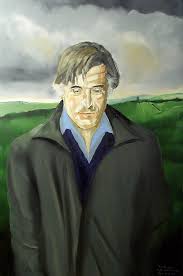In this post, notes of “Unit 2D: (i) Hawk Roosting by Ted Hughes” from “DSC- 13: Twentieth Century Poetry & Drama” are given which is helpful for the students doing graduation this year.
Introduction to Ted Hughes

Ted Hughes Biography
Ted Hughes was born on August 17, 1930, in Mytholmroyd, West Yorkshire, England. He was a very important poet in the 20th century and was the Poet Laureate of the United Kingdom from 1984 until he died in 1998. Hughes wrote strong and often unsettling poems about nature, myths, and human experiences.
He studied at Pembroke College, Cambridge, and later worked as a teacher and lecturer. Hughes was also married to American poet Sylvia Plath, and her tragic death in 1963 had a big impact on his writing. Their relationship has been widely talked about and influenced Hughes’ later poems.
Overview of His Writing Career:
Hughes’ writing career included both poetry and criticism. His first book, The Hawk in the Rain (1957), made him a well-known voice in British poetry. His poems often looked at the darker parts of life, including violence, death, and nature. Hughes is known for his vivid images and strong language, as well as his deep connection to myths and folklore.
During his career, Hughes published many poetry collections, such as Lupercal (1960), Crow (1970), and Birthday Letters (1998), which reflected on his relationship with Sylvia Plath. He also wrote plays, children’s books, and many critical essays. Hughes was praised for his unique poetic voice and won several awards, including the Whitbread Book of the Year Award and the Forward Poetry Prize.
Main Themes and Styles in His Poetry:
- Nature and Animals: Hughes often wrote about the raw aspects of nature, using animals to symbolize basic instincts and forces. In poems like “Hawk Roosting”, he uses a hawk to discuss power and control.
- Violence and Death: Many of Hughes’ poems deal with violence, seeing it as a natural part of life. His work explores the darker sides of both human and animal behavior, featuring themes of death and suffering.
- Myths and Folklore: Hughes was influenced by myths and legends. His Crow poems often use mythological symbols, with the crow representing chaos and change.
- Psychological Insight: Hughes’ writing also looks at human psychology, focusing on inner struggles and darker feelings. His Birthday Letters collection, in particular, reflects on his complicated relationship with Sylvia Plath and themes of memory and guilt.
- Language and Style: Hughes is known for his strong, sometimes harsh language. His poems can be intense and unsettling but are recognized for their clarity and striking imagery. The sounds, rhythms, and images he uses are important to his style, making his work powerful.
Hughes’ poetry often expresses awe and fear toward the natural world, and his works are an important part of British literature.
‘Hawk Roosting’
Hawk Roosting summary
Read Full Text: Hawk Roosting
In “Hawk Roosting”, Ted Hughes tells a dramatic story from the point of view of a hawk sitting high in a tree. The hawk talks about its strong power, its role as a predator, and its control over life and death. Through the hawk’s words, the poem looks at ideas of power, confidence, and the harsh realities of nature. The hawk speaks arrogantly, justifying its actions and seeing itself as the strongest creature in nature.
The hawk feels completely in charge—there is no doubt or modesty. It views itself as the king of the world, believing everything around it exists for its use. The poem shows the mindset of a predator that does not think about morals.
Hawk Roosting Themes
- Power and Control: The hawk represents complete power and control, not just over other animals but over its environment. It sees itself as the highest being in nature, unconcerned about anything except its own strength.
- Nature’s Brutality: The poem shows the harshness of the natural world through the hawk’s view. The hawk dominates its surroundings, reflecting that in nature, power is key, and survival can be cruel.
- Self-Assertion and Isolation: The hawk strongly believes in its own importance. This confidence makes it isolated, as it feels superior to others and does not need to connect with them. The hawk’s belief in its power highlights themes of loneliness that come with being dominant.
Hawk Roosting poem analysis
Poetic Devices:
- Imagery: Hughes uses strong images to show the hawk’s power. Phrases like “I sit in the top of the wood” highlight the hawk’s commanding position.
- Metaphor: The hawk’s view represents not just an animal’s thoughts but also bigger human ideas about control and power. The hawk seeing itself as the top being symbolizes how people or ideas can dominate others.
- Personification: The hawk’s thoughts are given human traits, allowing it to speak like a ruler, reflecting on its existence with authority.
- Symbolism: The hawk symbolizes unrestrained power and the harshness of nature, showing the dangers of absolute control.
Structure and Form:
- Free Verse: The poem is written in free verse, allowing the hawk to express itself freely. This style mirrors the hawk’s unchallenged strength.
- Dramatic Monologue: The poem is a dramatic monologue, where only the hawk speaks. This lets the hawk share its thoughts, creating a connection between the reader and the bird’s mindset.
Tone and Mood:
- Tone: The tone is cold and authoritative. The hawk speaks with calm confidence, showing no signs of doubt or remorse.
- Mood: The mood is unsettling and intense. As the hawk claims control over its world, the reader feels the weight of its power and the violence that comes with it.



